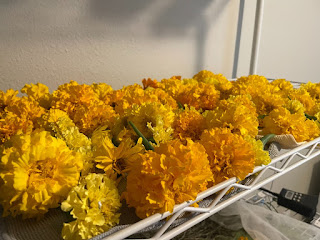 |
| Freshly trimmed marigolds set out to dry. |
An often overlooked aspect of gardening are the edible flowers and herbs. The benefits of these are two-fold: pests tend to stay away from strong scents and they're edible! So if you scatter flowers and herbs throughout your garden you then have a natural pest deterrent that you can also eat. In the case of pests whom like some pleasant scents, such as the Japanese beetle, the flowers and herbs will pull them away from your vegetables and into plants that you don't care as much about. It's important to note that even these dreaded beetles have scents that they do not like so diversity is key! There are a lot of benefits to growing flowers and herbs in your garden but the part that most people forget about is... eating them!
Marigold pedals are edible, pull a few pedals and top your salad with it. Nasturtiums are also edible, pop one in your mouth for an edible flavor explosion. Mint, thyme, catnip, sage, are all edible as well. You can also dry all of these. When you're in peak season, constantly trim the marigolds so they keep producing, lay out the marigolds inside in a single layer to let them dry. Once thoroughly dried they can be kept in a jar and used for herbal tisanes in the winter.
For the herbs, whenever you have time, give them a healthy pruning and stack them inside wherever you can or hang them from doorways to let them dry. The last way has the added benefit of allowing you to tell any visitors to the house that you're warding off witches. Once the herbs have dried, strip the leaves off into jars and again... you now have herbs for herbal tisanes or even soups in the winter.
Cut your edible flowers and herbs, dry them, store them for the winter then use them. They're much more useful that way then letting the frost and snow get the better of them.
No comments:
Post a Comment